In this presentation, Gary Klein shares important information about air source heat pump water heaters (HPWH), with particular attention paid to where the warm air comes ...
Diverter-Tee Q&A
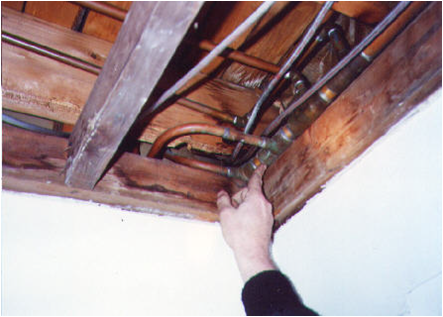
Q: What's the principle of the diverter-tee system?
A: This system lets you supply hot water to a radiator and return cooler water from the same radiator by using a single pipe.

Q: Is this why everyone calls it a "one-pipe" system?
A: Yes, the supply and return main are one and the same. Other types of hot water systems use one pipe to supply hot water to a radiator and a second pipe to return the cooler water from that same radiator to the boiler. We call these systems, "two-pipe."
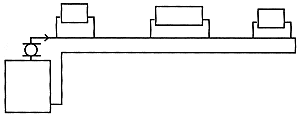
Q: How did the diverter-tee system come to be?
A: Back in the days when most folks used steam to heat larger buildings, the people who sold hot water equipment had a problem. How can you sell a heating system that requires two pipes when your competition (steam) only needs one? The answer was the one-pipe diverting tee system.
Q: Was this system widely accepted by contractors?
A: It sure was! Compared to steam, the one-pipe diverter tee system cost less to install, was quieter in operation and used much smaller pipes.
Q: Which manufacturers promoted this type of system?
A: Primarily Bell & Gossett. They brand-named their fittings, "Monoflo" and published a series of popular handbooks during the Thirties and Forties which explained how to size and install these systems. Taco also did a good job of promoting what they called a "venturi" fitting. For our purposes, however, we'll overlook the manufacturers' brand-names and just call lump them together as "one-pipe diverter tees."
Q: Were Bell & Gossett and Taco the first to come up with the idea of a diverter tee?
A: No, the credit for that goes to Oliver Schlemmer, a Cincinnati, Ohio heating engineer who designed and patented his O-S fitting in the early days of this century. Here's what the O-S fitting looked like.
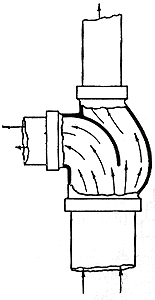
Q: Where would I find O-S fittings?
A: You'll find them on old gravity hot-water heating systems, the kind we went over in Chapter One.
Q: Where will I find the more-modern, one-pipe diverter tee systems?
A: Mainly in buildings constructed during the 1940s and 1950s. This system was very popular with home builders of the time because it offered them the benefits of hydronic heat without the labor-intensive aspects of steam- and gravity-hot-water heating.
Q: How does the diverter-tee work?
A: To answer your question, we first have to take a look at what goes on when water enters a standard tee.
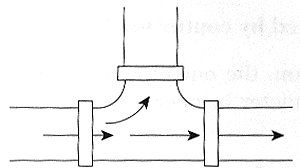
The water goes in one way, but it can come out in an infinite variety of ways. For instance, if four gallons per minute entered this tee from the left side, any combination of flows totaling 4 gpm would be possible through the two outlets. The flow could split in half with 2 gpm flowing through the side of the tee and 2 gpm flowing down the run? Or 3 gpm could go straight while 1 gpm traveled out the side. Anything is possible with a tee.
Q: Could all 4 gpm go straight through the tee with no flow whatsoever going through the side?
A: Sure! All it would take to make that happen would be a partially closed valve (or anything else that creates a restriction) in the branch piping.
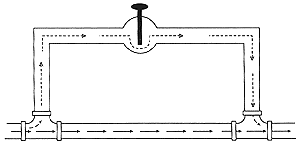
The valve increases the resistance to flow through the side of the tee, making it difficult for water to flow that way. So the water goes straight instead.
Q: Is this what we mean when we say water follows "the path of least resistance?"
A: Yes. Water will only flow from a point of high pressure to a point of low pressure. The greater the difference in pressure between those two points, the greater the flow will be. Anything that resists flow will lessen the difference in pressure between the two points, and that causes less water to flow that way.
Q: What would happen if that partially closed valve were in the piping between the two tees instead of in the branch piping?
A: You mean if you set the piping up like this?
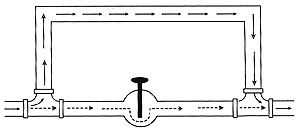
Well, then the resistance to flow along the main would increase. More water would flow through the branch piping and less water would flow along the main. The water will always follow the path of least resistance.
Q: Suppose you had your piping set up that way with two standard tees and no valves. Would any water flow through the branch piping then?
A: You mean like this?

Piped this way, some water might flow through the branch, but my guess is most of the water would follow the path of least resistance and flow along the main. How come? It's just easier for it to go that way.
Keep in mind water won't necessarily flow through a pipe just because you have it connected to another pipe.
Q: How much, if any, water would flow through the branch in this case?
A: It depends entirely on the difference in pressure between the two standard tees.

The greater the difference in pressure between these two points, the more water will flow through the branch. If there's hardly any difference in pressure between the tees, very little, if any, water will flow through the branch.
Q: Is there usually much difference in pressure between two standard tees?
A: Not if they're placed closely together. The only difference would be the friction the water creates as it flows along the main between the two tees. The closer you place the tees, the less friction, and the less pressure difference, there will be. That's why we need diverter tees to make this type of one-pipe system work.
Q: Wait a minute. Couldn't I just reduce the size of the pipe between the two standard tees? That would increase the friction in the main and create more of a difference in pressure between the two tees. Would that work?
A: Sure it would.
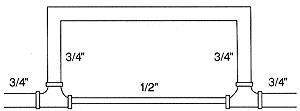
You know why? Because some of the water will find it easier to go through the 3/4" branch piping than it will through the 1/2" main.
Q: How much water will flow through the branch?
A: That still depends on the difference in pressure between the tees. It's very difficult to tell. A lot depends on the lengths of the pipe.
Q: Suppose, in this case, my branch circuit is very long. Will water still flow that way?
A: Maybe, maybe not. It still comes down to a question of how much difference in pressure you have between those two tees.
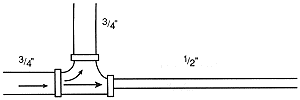
Let's look at the water's choices as it enters the tee on the left. It can go straight and put up with the pressure drop of the 1/2" pipe between the two tees. Or it can enter the branch and deal with the pressure drop the long, branch piping offers.
Q: But wait a minute, the branch piping is wider than the main piping. Why should there be more pressure drop going that way?
A: It's because of the relative lengths of the two paths. There's more to this than just the width of the pipes, you know. The branch pipe is wider, sure, but it's also longer. The main pipe, on the other hand, is smaller by a full size than the branch pipe, but it's also shorter.
It still comes down to a question of difference in pressure between the tees.
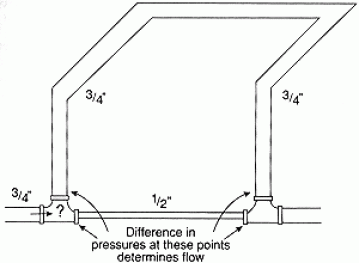
Q: Does this mean the length of the run to the radiator is important?
A: It's very important. I remember seeing a job where an installer connected nearly 200 feet of baseboard radiation to a single diverter tee off a one-pipe supply main.

He couldn't understand why the baseboard wouldn't get hot. He was missing the key point - there was very little, if any, water flowing through the baseboard. And where there is no flow, there can be no heat.
Q: So just because I pipe a radiator into a main doesn't necessarily mean it's going to work?
A: Right, wishing and hoping will take you just so far. It always comes down to the differences in pressure between the tees and how much water flows through the main and through the branch. You have to think of flow as though it were a train on which heat travels like a passenger.
Q: So the diverter tee's job is to direct the flow into the branch?
A: Yes. It sets up a fixed resistance to flow along the main. The resistance drives a portion of the water into the branch. Here, take a look inside this one.
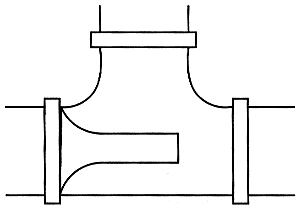
Diverter tees work because they change the water's path of least resistance.
Q: Why is that cone inside the tee?
A: The cone creates a narrow opening through which the water has to pass if it's going to continue flowing along the main. Since the cone makes it tough for all the water to go straight, some of the water will divert into the branch.
Q: Does it matter which way I face the cone?
A: Yes. If you're using one tee, it's best to put it on the return side with the wide end of the cone receiving the flow.
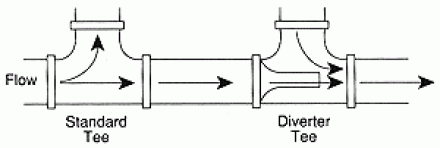
Q: If the cone is on the return side, how can it divert the water up into the radiator?
A: You'll have to use your imagination to see what's going on here. Think of yourself as the water. You're flowing down the main toward the set of tees leading into the radiator. The first is a standard tee, the second, a diverter tee. You look up ahead and see a bottleneck on the main "road." That's the "traffic jam" the cone is causing. Things are slowing down so you decide to take the "service road" through the branch.
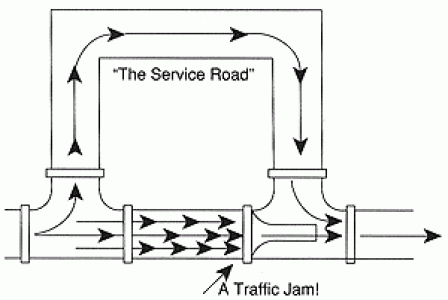
Once they're past the cone, the two flows - one from the main and the other from the branch - join again and continue to the next set of tees. Get it?
Q: So the diverter tee's not "scooping" the water up into the radiator, is it?
A: No, it's just creating resistance along the main. The water follows the path of least resistance through the branch.
Q: Could I turn the diverter tee around so the cone points toward the flow and use it as the first tee instead of the second?
A: You could, and it will work because the same principle applies: the diverter tee increases the pressure drop along the main and creates flow in the branch.
However, with the cone facing into the flow, the water will be a bit more turbulent and, if you're using enough tees, you might have to use a larger circulator to overcome the additional pressure drop caused by the turbulence. That's why most old-timers put the diverter tee on the return side with the wide end of the cone facing the flow.
Q: Do I need one or two diverter tees?
A: It depends on how much pressure drop you have to apply along the main to get the flow you need through the branch. As a rule of thumb, you should use one diverter tee if the radiator is above the main (using it as the return tee) and two diverter tees if the radiator is below the main.
Q: Why do I need two tees if the radiator is below the main?
A: Because hot water if buoyant and doesn't want to go down. The second diverter tee increases the pressure drop along the main and helps coax the hot, buoyant water down into the radiator.
Q: Suppose I use only one diverter tee to feed a radiator that's below the main. What might happen?
A: Most likely, you won't get the flow you need through that radiator. And you probably won't get the right amount of heat out of the radiator on the colder days of the year.
Q: I'll only notice the problem on the colder days of the year?
A: Probably, because we all size radiators to overcome the worst-case heat-loss condition. On milder days, the radiator is, in effect, oversized. The heat you'll get from it is enough to make the room comfortable on a mild day, but on a really cold day, the flow won't be there to bring enough heat to the radiator.
Q: Will venting the radiator help?
A: No because this is a flow problem...it ain't an air problem.
Q: But when I vent the radiator, it does get hot all the way across and seems okay for a while. What's going on?
A: By opening up the vent on the radiator, you're temporarily changing the water's path of least resistance. It suddenly finds it easier to flow into the branch and toward the radiator because the vent is wide open to the atmosphere. In fact, the flow comes down from both the supply and return pipes when you open the vent. See? It's still a matter of pressure differential, but with the vent wide open, the water moves from, say, 12 psig system pressure to atmospheric pressure. That's why you get a temporary increase in flow rate and a corresponding increase in heat from the radiator. But as soon as you close the vent, the situation goes back to "normal" and your radiator goes cold again.
Q: So with diverter-tee systems it's easy to confuse flow problems with air problems?
A: It's very easy to confuse the two. Any type of finned-tube radiation (baseboard or convectors) has the ability to give up a lot of heat in a short amount of space. If the flow rate is less than it should be, the front end of the radiator will be hot and the back end will be cooler. To the touch, it appears to be an air problem, but it's not.
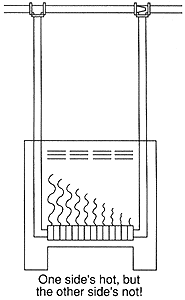
Q: How will I be able to tell an air problem from a flow problem?
A: If you don't get air when you vent the radiator, it ain't an air problem! So stop venting.
Q: Is there a way of connecting radiators to minimize air problems?
A: When the old-timers used free-standing radiators, they usually connected them bottom-and-bottom, like this.
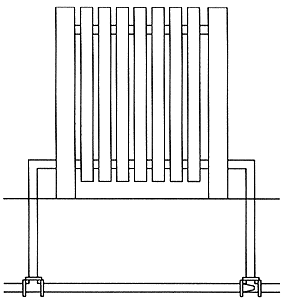
Piped this way, water will continue to flow through the radiator, even if some air accumulates at the top.
Q: Will the water short-circuit through the radiator if I pipe it this way?
A: The hotter water will generally rise up into the radiator, displacing the colder water, because a free-standing, cast-iron radiator is a "wide space in the road." The flow through it is relatively slow so the hotter water rises.
Q: What happens if I pipe this radiator with one pipe at the top and the other at the bottom?
A: You mean like this?
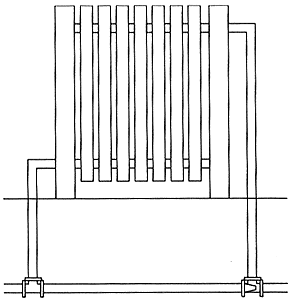
Well, if you put either the supply or the return at the top, trapped air will be able to stop circulation through the radiator if enough gathers and creates an "empty space" up there at the top.
Q: How close together in the main can I pipe the two tees?
A: When the radiator is above the main, the tees can be as close together as six inches (if they're Bell & Gossett's tees) or 12 inches (if they're Taco's tees). If you have the radiator below the main, the tees have to be as wide apart as the ends of the radiator. This is very important.

Q: Why do the tees have to be so wide apart on a down-feed system?
A: Again, because the water in the main is hotter and more buoyant than the water in the radiator. It doesn't "want" to go down. By spacing the tees further apart, you increase the resistance to flow along the main and drive more water down through the radiator.
Q: Is the distance to my radiator important here?
A: Yes, try to keep the piping to and from the radiator as direct as possible. By avoiding a lot of unnecessary fittings you'll minimize the pressure drop going to the radiator and help establish circulation.
Q: Suppose I have a long run of baseboard radiation and it's below the main. How can I place those tees "the width of the radiation apart?"
A: It's difficult, isn't it? And this is a common problem many installers run into with these systems. Someone will replace an old convector with a long run of baseboard. He'll use the existing diverter tees, and then find the baseboard won't heat as well as the old convector did. There's too much resistance to flow through that long run of baseboard so most of the water bypasses the radiation and flows along the main.
Q: Does this one look like an air problem?
A: It looks like the worst air problem you've ever seen.
Q: But when I bleed the baseboard I don't get any air so it can't be an air problem, right?
A: Right, if you don't get air...it ain't an air problem.
Q: Can I solve the problem by using a larger circulator? Maybe a "high head" circulator?
A: If you try to jam more water down the pipe, you'll probably change the pressure differential relationship between the tees, and you may get a bit more flow through the radiator. But then your customer will probably also get velocity noise, higher electricity bills and an unwillingness to pay you. Here, as in most systems, finesse works better than brute force.
Q: So how can I solve this problem with the cold baseboard?
A: The best way would be to run the baseboard radiation as a separate zone if it really has to be that long to overcome the heat loss. Keep in mind, the heat loss of the room determines the amount of baseboard you need, not the length of the wall. Maybe you should check the length of the run before you do anything else. You know, see if you really need that much.
Q: Let's say I do need that much. Is there any other way around this problem of not having enough flow through the baseboard?
A: You could run the baseboard as a part of the main within the diverter-tee system.
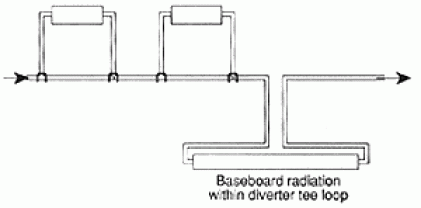
Make sure you cut out the two diverter tees and the main piping between the tees, and then just make the baseboard radiation a part of the main.
Q: Can't I just leave the tees in there?
A: No, with one of the outlet holes plugged, the tees will add too much resistance to the flow and may create insufficient flow problems everywhere.
Q: If I connect the baseboard as a part of the loop, can it be anywhere in the system?
A: It's best if it's the last thing on the loop.
Q: Why is that?
A: Because there's a good chance someone oversized the baseboard radiation, running it from wall-to-wall with no consideration of heat loss. If the baseboard is the last radiator on the line, the water will be relatively cool. It won't over-heat the room as much as it would if it were the first thing on the line.
Q: If it were first on the line, could it cause any other problems?
A: If it's over-sized and first on line, it might take too much heat out of the water. By the time the cooler water reaches the other radiators, it might not be carrying enough heat to keep the folks warm on the colder days of the year.
Q: Suppose I just want to get rid of a radiator. Do I have to get rid of the diverter tees, or can I just cap them off?
A: You can't close one of those outlets and expect to get the flow you were getting before. The pressure drop will be much greater.
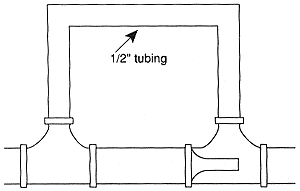
You can leave the tees in line if you connect the branches with a 1/2" copper line. That gives the water somewhere to go and keeps things pretty much as they were before you cut the radiator off the line.
Q: What's the best way to connect the radiators to the main if the system has radiators both above and below the main?
A: Alternate the feeds and returns like this.
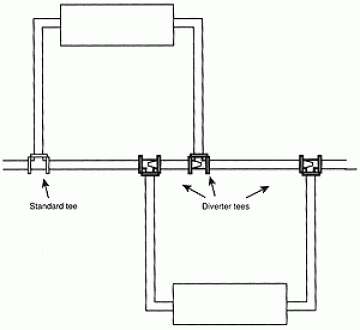
Having the additional pressure drop of the upper radiator's diverter tee between the two down-feed diverter tees assists flow to the lower radiators.
Q: Do I have to pitch the main in a diverter-tee system?
A: If most of the radiation is below the main, you have to pitch the main at least one-inch in twenty feet in the direction of flow. You'll also need an air vent at the end of the main to help you get rid of the air on start-up.
If most of the radiation is above the main, the pitch is not as crucial. The main, in this case, can be level, but a slight pitch in the direction of flow is always a good idea.
Q: Do I have to pitch the radiators as well?
A: It helps to pitch them up slightly in the direction of flow and to put an air vent on the return side of each one.
Q: When I'm troubleshooting, should I look for this pitch?
A: Yes, especially on the basement mains because people hang things on their basement heating pipes - laundry, lumber, children (they do pull-ups!), you name it. As you lose that one-inch-in-twenty-foot pitch, air problems develop.
Q: Is it difficult to get the initial air out of a diverter-tee system when you first start it up?
A: Yes, it usually is because the air goes to the top of the system where the water is coolest and the pressure is lowest.
Q: Is there any trick I can use to help me get rid of the start-up air?
A: Air will dissolve in water in proportion to its pressure. The higher the pressure, the more readily the air will go into solution. If you raise the system fill pressure to a point where it approaches the relief valve setting, more air will go into solution.
Q: What do you mean by "in solution?"
A: It doesn't appear as bubbles. It's invisible in the water and not a problem in the radiator.
Q: So, in other words, if I raise the fill pressure I'll have fewer air bubbles at the top of the system.
A: That's right, but you'll have to remember to reset the fill pressure to the proper setting after you've cleared the air. If you leave fill pressure at a too-high setting, your compression tank will be, in effect, undersized.
Q: When most of the radiators are below the main, I usually have a tough time getting rid of the start-up air. Are there any tricks that can help me with these?
A: There's one that works pretty well. When down-fed radiators won't heat because of air-related flow problems, most installers raise the water temperature. They believe the hotter water will move more quickly into the radiator. It seems to make sense - and that's why it doesn't work.
The trick, in this case, is to do what doesn't make sense. Instead of raising the water temperature, lower it. Then stand back and watch how much more quickly those down-fed radiators heat.
Q: How come that works?
A: Because the hotter the water is, the lighter it becomes. When you first start the system, the water in the radiators is cooler and heavier than the water that's circulating through the main. If trapped air is slowing the flow through the down-fed radiators, the water in the radiators won't have a chance to heat and become more buoyant. If you raise the water temperature, you aggravate the situation. But by lowering the water temperature, you'll bring the density of the water in the main closer to the density of the water in the radiators and have a much better chance of establishing circulation. Try it, you'll see what I mean.
Q; I've heard I should pipe my circulator so it pumps away from my compression tank. Is that true?
A: The circulator will always work best in this position, especially on these systems.
Q: How come?
A: Because, as I said, air dissolves in water in proportion to the pressure applied to the system. When you pump away from the compression tank, you add the circulator's differential pressure to the system's fill pressure. When you pump toward the compression tank, you remove the circulator's differential pressure from the system's fill pressure. It's to your advantage to use the circulator's pressure every time the system runs. Trapped air bubbles will always go into solution more easily when the pressure is high.
Q: If I'm using a "high-head" circulator and I have it installed on the return, pumping toward the compression tank, will I have an even tougher time getting rid of the air?
A: You sure will. The higher the pump head, the greater the drop in pressure when it starts. Water-lubricated circulators can drop the system pressure in a typical house by about half the static fill pressure. The result is dramatic - air binding and air noise. Move the circulator to the supply side of the system, pumping away from the compression tank and you'll see the difference immediately.
Q: How do diverter tees affect my circulator size?
A: Since this is a one-pipe system, all the water has to pass through all the tees. That means the pressure drop through diverter tees is cumulative .
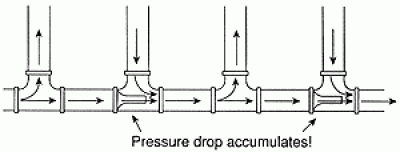
The more diverter tees you have, the more head pressure your circulator will have to develop.
Q: How can I avoid having a circulator that's too large?
A: By splitting the loop.
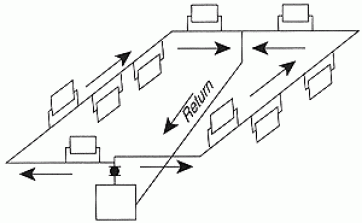
You have to size your circulator for the total system flow at the pressure drop of the circuit with the greatest resistance. By splitting the loop, the highest-pressure-drop circuit will have only a portion of the tees.
Compare this split-loop piping to a the same system with only one loop.
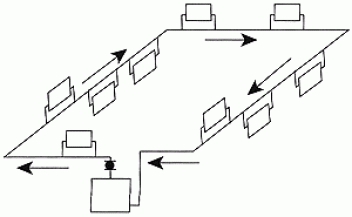
Do you see how all the water has to flow through all the tees now? The circulator has to overcome the cumulative pressure drop of each one of those tees. But in the split-loop system, the highest-pressure-drop circuit has only some of the tees. The result is usually a smaller circulator.
Q: How do I size diverter tee systems?
A: The capability of diverter tees vary from manufacturer to manufacturer so it's best to refer to their sizing charts. They'll ask you how much water you have flowing through the main and how much of that water you want to pass into the branch leading toward the radiator. Your Btu/hr loads will determine the flow rates in both the main and the branches. If you've sized your system for a 20-degree F temperature drop from supply to return, each gpm of flow will carry 10,000 Btu/hr of heat.
Q: Can you give me an example of how a manufacturer might size a system?
A: Sure. Let's say you have a system with a total heating load of 40,000 Btu/hr. If you're working with a 20-degree F temperature drop, you'll want to circulate 4 gpm through the main (each gpm carries 10,000 Btu/hr when the temperature drop is 20 degrees F). Now, let's say your first radiator needs 10,000 Btu/hr. That load represents 1 gpm. So the manufacturer would try to size the diverter tee (or tees) to pass 1 gpm into the radiator. Naturally, 3 gpm would be flowing along the main, between the two tees, while this is going on.
The two flows (1 gpm and 3 gpm) will rejoin on the return side of the radiator and to make up 4 gpm you started with.
Q: Won't this rejoined flow be cooler?
A: Yes, because some of the heat hopped off in the radiator.
Q: How can I tell how much cooler the water will be when it heads off toward the next radiator?
A: If you know the flow rates and the Btu/hr loads, you can work a simple formula to find out. It deals with the conditions in the return tee and it goes like this.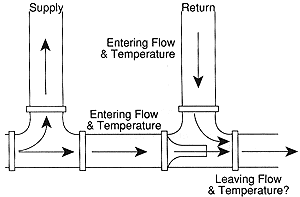
Entering Flow of the Run) X (Entering Temperature of the Run) + (Entering Flow of the Branch) X (Entering Temperature of the Branch) = (Leaving Flow of the Tee) X ("X" The Unknown Temperature)
Q: Can you give me an example of this?
A: Sure, here are some real numbers.
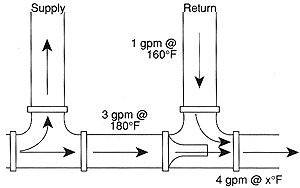
Here we have 3 gpm of 180 degree F water entering the run of the tee and 1 gpm of 160 degree F water entering from the branch. We know the combined leaving flow rate will be 4 gpm. What we don't know is the temperature of that mixed flow. Plug the numbers into the formula:
(3 gpm) X (180 degrees F) + (1 gpm) X (160 degrees F) = (4 gpm) X ("X" the unknown temperature)
540 + 160 = 4 X
700 = 4 X
700/4 = X
175 = X
Q: So the temperature of the water heading to the next radiator will be 175 degrees F?
A: That's right. There will be 4 gpm of 175-degree F water heading entering that radiator.
Q: Will this radiator have to be larger than the first?
A: It might have to be since it's working with cooler water. It all depends on the heat loss of the space the radiator has to heat.
Q: Does this mean with diverter tees systems it's best to supply the areas of largest heat loss first because the water will be hotter?
A: Not necessarily, it depends on the size of the radiators. You're going to have to size each radiator for the space it serves, no matter how you look at it. Where most installers go wrong is by over-sizing everything. They're trying to cover themselves, but they usually wind up with over- and under-heated rooms and unhappy customers.
Q: Do the manufacturer's sizing charts show all these variables?
A: No, basically they show you the flow rates you can expect in a given situation if you use one or two tees.
Q: Will I always be able to get the exact flow rate I need?
A: Probably not. More often than not you'll have to settle for a little more or a little less. For example, let's say a diverter-tee manufacturer's sizing chart shows you can't get that 1 gpm you were looking for by using one tee because your piping to the radiator is too long. The manufacturer does show, however, that by using two tees, you can get, let's say, 1-1/4 gpm. It's more than you need, but it will get the job done.
Q: Is there no other way around this?
A: Oh sure there is. There's usually a way around most everything in heating, but there's also a price. In this case, you could use larger pipe between the main and the radiator. That would lessen the branch-circuit pressure drop and save you from having to buy that second diverter tee. Whether or not you choose to do this depends on how much time and money you'd have to invest in the decision. Most people, I've found, would opt for the second diverter tee.
Q: But won't that additional diverter tee increase the size of my circulator?
A: It will, and this is one of the things you have to balance when you first look at the system. There's no free lunch!
Q: Why don't we see installers putting in diverter-tee systems anymore?
A: Beats me! I think it's a fine system, but it does require more thought than the system we're going to look at next.
Leave a comment
Related Posts

In this all-technical three-hour seminar, Dan Holohan will give you a Liberal Arts education in those Classic Hydronics systems. He’ll have you seeing inside the pipes as...
We always have turkey for Thanksgiving. I mean who doesn’t? My job wasn’t to cook it, though; it was to eat it.